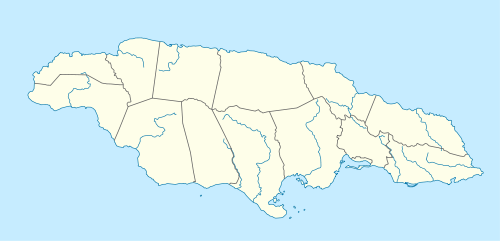Rio Bueno, Jamaica

Rio Bueno is a settlement in Jamaica. It has a population of 1,096 as of 2009.[1]
Rio Bueno, is a small seaside village on the border between the parishes of St Ann and Trelawny, and owes its importance, history and livelihood to the Rio Bueno Harbour. The Rio Bueno Harbour is the deepest in Jamaica, perhaps one of the reasons why Columbus dropped anchor there on his first visit to Jamaica.
History
The village sprung up during the early days of English Colonialism as a way stop for both maritime and overland visitors, and it traditionally housed taverns, guesthouses and inns. It used the postmark A70[2] when the post office opened in 1859ca. By the late 1800s the town was almost deserted, a shadow of its former self, but was then resurrected by the construction of a bauxite-shipping wharf in the mid-1900s.
The village remains a picturesque gem steeped in history, with its old fort, warehouses and churches set against the water’s edge with the green hills of Trelawny as its backdrop. [3]
Churches and forts
Rio Bueno boasts many churches, two of which are of great historical importance to both Jamaica and the area. Baptist missionaries who broke away from the Church of England originally built the Rio Bueno Baptist church in 1829. The Rio Bueno Baptist church was, for a short while, the major place of worship and education for converted blacks living in the area. The humble meeting hall lasted only three short years before members of the Colonial Church Union, a band of vigilante white planters, merchants and estate workers intent on displacing the support base of the nonconformist missionaries, burnt it to the ground. The Baptists, however, were not to be underestimated, and by 1834 a new Baptist chapel was built. Both churches exist in harmony today, each relishing its colorful and longstanding history, both celebrating worship on Sunday mornings with their discrete congregations.
In the West end of Rio Bueno is the ruins of Fort Dundas. The fort dated from the late 18th / early 17th century when Jamaica's Governor, Lord Balcarres, commissioned it to defend Jamaica against the threat of attacks from Cuba. Fort Dundas gets its name from the British Secretary of War at the time, Henry Dundas.[4]
References
- ↑ "Jamaica: largest cities and towns and statistics of their population". World Gazetteer. Archived from the original on 5 December 2012. Retrieved 21 December 2009.
- ↑ Stanley Gibbons Stamp Catalogue 1840-1970, 2009.
- ↑ http://www.visitjamaica.com/rio-bueno
- ↑ http://www.jamaicatravelandculture.com/destinations/trelawny/rio-bueno.htm
External links
Coordinates: 18°28′44″N 77°28′19″W / 18.479°N 77.472°W
